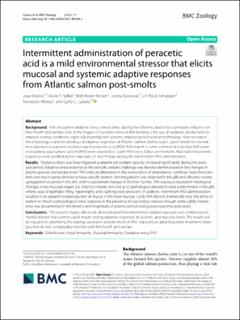| dc.contributor.author | Osório, João | |
| dc.contributor.author | Stiller, Kevin Torben | |
| dc.contributor.author | Reiten, Britt Kristin Megård | |
| dc.contributor.author | Kolarevic, Jelena | |
| dc.contributor.author | Johansen, Lill-Heidi | |
| dc.contributor.author | Afonso, Fernando | |
| dc.contributor.author | Lazado, Carlo C. | |
| dc.date.accessioned | 2022-04-12T09:18:04Z | |
| dc.date.available | 2022-04-12T09:18:04Z | |
| dc.date.created | 2021-11-30T10:05:01Z | |
| dc.date.issued | 2022 | |
| dc.identifier.issn | 2056-3132 | |
| dc.identifier.uri | https://hdl.handle.net/11250/2991032 | |
| dc.description.abstract | Background Fish encounter oxidative stress several times during their lifetime, and it has a pervasive influence on their health and welfare. One of the triggers of oxidative stress in fish farming is the use of oxidative disinfectants to improve rearing conditions, especially in production systems employing recirculation technology. Here we report the physiological and morphological adaptive responses of Atlantic salmon (Salmo salar L.) post-smolts to intermittent exposure to a potent oxidative agent peracetic acid (PAA). Fish reared in semi-commercial scale brackish water recirculating aquaculture system (RAS) were exposed to 1 ppm PAA every 3 days over 6 weeks. Mucosal and systemic responses were profiled before exposure, 22 and 45 days during the intermittent PAA administration. Results Oxidative stress was likely triggered as plasma antioxidant capacity increased significantly during the exposure period. Adaptive stress response to the periodic oxidant challenge was likewise demonstrated in the changes in plasma glucose and lactate levels. PAA-induced alterations in the transcription of antioxidants, cytokines, heat shock proteins and mucin genes showed a tissue-specific pattern: downregulation was observed in the gills and olfactory rosette, upregulation occurred in the skin, and no substantial changes in the liver. Further, PAA exposure resulted in histological changes in key mucosal organs (i.e. olfactory rosette, skin and gills); pathological alterations were predominant in the gills where cases of epithelial lifting, hypertrophy and clubbing were prevalent. In addition, intermittent PAA administration resulted in an apparent overproduction of mucus in the nasal mucosa. Lastly, PAA did not dramatically alter the ability of salmon to mount a physiological stress response in the presence of a secondary stressor, though some subtle interference was documented in the kinetics and magnitude of plasma cortisol and glucose response post-stress. Conclusions The present study collectively demonstrated that intermittent oxidant exposure was a mild environmental stressor that salmon could mount strong adaptive responses at systemic and mucosal levels. The results will be valuable in optimising the rearing conditions of post-smolts in RAS, especially in adopting water treatment strategies that do not considerably interfere with fish health and welfare. | |
| dc.description.abstract | Intermittent administration of peracetic acid is a mild environmental stressor that elicits mucosal and systemic adaptive responses from Atlantic salmon post-smolts | |
| dc.language.iso | eng | |
| dc.title | Intermittent administration of peracetic acid is a mild environmental stressor that elicits mucosal and systemic adaptive responses from Atlantic salmon post-smolts | |
| dc.title.alternative | Intermittent administration of peracetic acid is a mild environmental stressor that elicits mucosal and systemic adaptive responses from Atlantic salmon post-smolts | |
| dc.type | Peer reviewed | |
| dc.type | Journal article | |
| dc.description.version | publishedVersion | |
| dc.source.volume | 7 | |
| dc.source.journal | BMC Zoology | |
| dc.source.issue | 11 | |
| dc.identifier.doi | 10.1186/s40850-021-00100-x | |
| dc.identifier.cristin | 1961419 | |
| dc.relation.project | Norges forskningsråd: 237856 | |
| dc.relation.project | Fiskeri- og havbruksnæringens forskningsfinansiering: 901472 | |
| cristin.ispublished | true | |
| cristin.fulltext | original | |
| cristin.qualitycode | 1 | |
